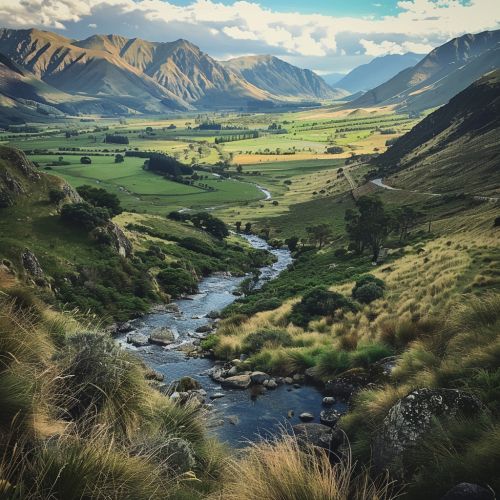Fluvial landforms
Introduction
Fluvial landforms are features created by the action of rivers and streams. These landforms are part of the broader category of geomorphic features, which also include coastal and glacial landforms. Fluvial landforms can be categorized into erosional landforms, depositional landforms, and landforms created by river channel migration.
Erosional Landforms
Erosional landforms are created by the erosive power of flowing water. They include features such as valleys, canyons, and gorges.
Valleys
Valleys are one of the most common fluvial landforms. They are typically characterized by a V-shape, with the point of the V being the river channel. The sides of the valley are known as valley walls or valley slopes, and the bottom is known as the valley floor. The shape of a valley is determined by the balance between the power of the river to erode downward, and the ability of weathering processes to widen the valley.


Canyons and Gorges
Canyons and gorges are similar to valleys, but are typically narrower and deeper. They are formed when a river cuts through layers of rock, creating steep, often vertical, walls. The term 'gorge' is often used to describe a narrow canyon with steep, rocky walls.
Depositional Landforms
Depositional landforms are created by the deposition of sediment carried by the river. These include features such as floodplains, deltas, and alluvial fans.
Floodplains
A floodplain is a flat area of land adjacent to a river, formed by the river's recurrent flooding. During a flood, the river overflows its banks and deposits sediment on the floodplain. Over time, this process creates a flat, fertile area that is often used for agriculture.
Deltas
A delta is a landform that forms at the mouth of a river, where the river flows into an ocean, sea, estuary, lake, or reservoir. Deltas are formed from the deposition of the sediment carried by the river as the flow velocity decreases upon reaching a standing body of water.
Alluvial Fans
An alluvial fan is a fan-shaped deposit of sediment formed when a fast-flowing river slows down, typically at the exit of a canyon onto a flatter plain. The change in slope causes the river to drop its sediment load, forming a fan-shaped deposit.
Landforms Created by River Channel Migration
River channel migration can create a variety of landforms, including meanders, oxbow lakes, and terraces.
Meanders
Meanders are bends in a river that form when the river erodes the outer banks and deposits sediment along the inner banks. This process causes the river to snake back and forth across its floodplain.
Oxbow Lakes
An oxbow lake is a U-shaped body of water that forms when a wide meander from the main stem of a river is cut off, creating a free-standing body of water.
Terraces
Terraces are flat or gently sloping surfaces that flank the sides of a river. They are remnants of former floodplains that have been left high and dry as the river has cut downward into its bed.
